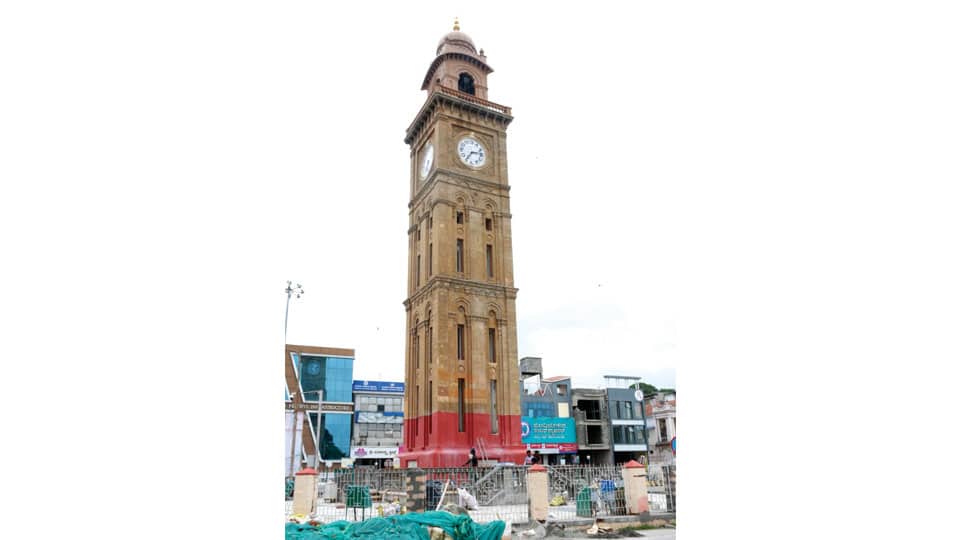Ongoing restoration works at Rs. 42 lakh to be completed in 20 days, says Heritage Department Commissioner Devaraju
Mysore/Mysuru: The restoration works of Big Clock Tower (Doddagadiyara) in the heart of the city has been almost completed, signalling to start ticking in the 97th year of its existence.
The 75-foot tall clock tower was built opposite Rangacharlu Memorial Town Hall, to commemorate the 25th year (silver jubilee) reign of the then king Nalwadi Krishnaraja Wadiyar and was inaugurated on Aug. 8, 1927. The round shaped clocks can be seen on all the four sides of the tower, with Kannada digits, embodying the pride of Kannada language.
It is said that, whenever the clocks chimed at every one hour, the sound could be heard till a distance of 5-km. As the years progressed, the clocks developed repair and from the year 1990 afterwards, the clocks stopped chiming, except for remaining functional.
A. Devaraju, Commissioner, Department of Archaeology, Museums and Heritage said “Restoration works were launched close to a year ago in August 2023 and are expected to be completed in 15 to 20 days, provided there is a respite from rains. The works were taken up at an estimated cost of Rs. 42 lakh sanctioned by Mysuru City Corporation (MCC) and were carried out without compromising on the heritage significance and adhering to regulations related to conservation of heritage structures.
A mixture of lime mortar and sand from river banks have been used in the restoration works while M-sand is used to close the rat burrows dug by rodents. The same construction materials have been used in the ongoing restoration works of Postal Training Centre (PTC) building at Nazarbad in the city, added Devaraju.
He also clarified that the works have been executed in compliance with the suggestions of experts from Deccan Heritage Foundation (which is involved in the restoration works of Jayalakshmi Vilas Mansion in Manasagangothri) and also the heritage experts of the city. The windows, window frames, glasses, shutters and stones covering the surface of the platform have been conserved, using the equipment recommended by heritage experts.
The maintenance of the clock tower rests with the MCC, which is believed to have already entrusted the task to an individual, said Devaraju.
Heritage expert points at loopholes
The restoration works have been not carried out in accordance with the plans. Had the burrows been closed with stone slabs, the lawns could have been developed, but M-sand is used in filling the burrows. The M-sand is also used to plaster the walls of the tower, that won’t go well with the lime mortar used in vogue earlier. Despite raising these pertinent issues, the contractor didn’t respond. The mortar should be prepared from a mixture of lime, sand, mara vajra, egg, jaggery syrup and antuvala kayi (soapnut). But the mixture of M-sand and cement are used in the works. The colour paint has been used to paint around the bell on the top. There were four domes around the bell and two among them were in deplorable condition. Instead of restoring them, they have been removed. Instead of involving those without expertise to carry out heritage related works, the Department of Archaeology, Museums and Heritage, should have executed the works on its own. — Prof. N.S. Rangaraju, Heritage Expert








Recent Comments